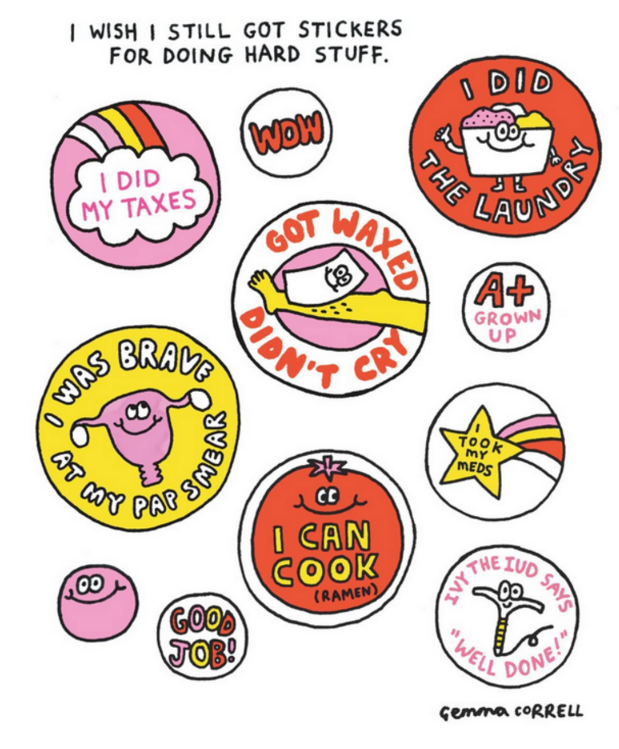These Cartoons Sum up What Living With Anxiety Feels Like

By:
Anxiety is the most common mental health illness in the U.S. and yet, most people are hesitant to talk about it because mental health is still stigmatized and misunderstood.
Though it's safe to say that most people have experienced some form of mild anxiety—butterflies before a big speech or the restless feeling that comes with waiting to hear back from a coveted job interview—it can be tricky to know when it's just a one-time deal and when it's a problem that affects daily functioning. How does it look when anxiety gets in the way of daily life?
Through a series of humor-based cartoons, illustrator Gemma Correll exposed what it feels like to have anxiety in every day situations in the book,"The Worrier's Guide To Life."
Related: People Are Loving These Inspiring Instagram Photos About Mental Illness
 Gemme Correll/A Worrier's Guide To Life - co.uk
Gemme Correll/A Worrier's Guide To Life - co.uk
 Gemma Correll/A Worrier's Guide To Life - co.uk
Gemma Correll/A Worrier's Guide To Life - co.uk
Stressing over a phone call or getting preoccupied over strangers laughing may seem like hyper-awareness yet often these little and seemingly "insignificant" situations are more frightening for someone with anxiety. For them, these everyday scenarios produce so much worry that it really is like living in a horror movie.
Related: Boost Your Mental Health in 2016
What can make anxiety complex is that it can take on different forms: social anxiety, panic disorder, post-traumatic stress disorder, obsessive compulsive disorder to specific phobias, each having its own debilitating circumstances. Depending on the type, anxiety can cause a variety of symptoms including heart palpitations, shortness of breath, insomnia, tension and avoidance behaviors.
Although the symptoms of anxiety can range, the overwhelming and irrational sense of worry, fear and uneasiness is what underlies all forms of anxiety, especially generalized anxiety disorder (GAD). According to Psych Central, people who suffer from GAD experience a fatalistic approach to life. They tend to anticipate disaster and excessively worry about situations even though their concern is not warranted. And despite their wholehearted effort, those who suffer from GAD cannot seem to eliminate their worries even though they recognize their concerns are irrational.
 Gemma Correll/The Worrier's Guide To Life - co.uk
Gemma Correll/The Worrier's Guide To Life - co.uk
Correll was hesitant to publish her cartoons at first for fear that people might have a bad response."I didn't have the confidence to share [my work about anxiety] for some time," Correll told i100. "I was scared of the reactions that I might get and what people would think of me."
Correll's fear is unfortunately justified. The fear and stigmas associated with mental health can be traced back centuries. According to Psychology Today, people with mental health were often "treated differently, excluded and even brutalized" based on the perception that mental health sufferers were "uncontrollable and violent." And today, the way in which mental health patients are studied implies that "people with mental health problems are in some ways "different from normally functioning individuals" and they may be "associated with undesirable attributes," according to the article. For people dealing with anxiety, these negative perceptions only hinder people from seeking the help and relief they need from their illness, something that led Cornell to express her anxiety through illustrations.
 Gemma Correll/The Worrier's Guide To Life - co.uk
Gemma Correll/The Worrier's Guide To Life - co.uk
On her decision to inject some playfulness into the cartoons, Correll told i100: "Humour can be a powerful weapon against painful experiences and feelings.Sometimes, when everything seems to be going wrong, or you feel bad, all you can do is laugh." As ATTN: has previously reported, cartoons have become a popular method to illustrate complex issues like sexual assault and consent or workplace harassment. Their casual nature and brevity help to explain concepts that are ambiguous or taboo in an easy-to-digest manner. Correll's playful approach to anxiety is another excellent example of how humor can make a stigmatized issue more accessible and relatable.
You can see the other illustrations from Correll below.
 Gemma Correll/The Worrier's Guide To Life - co.uk
Gemma Correll/The Worrier's Guide To Life - co.uk
 Gemma Correll/The Worrier's Guide To Life - co.uk
Gemma Correll/The Worrier's Guide To Life - co.uk
